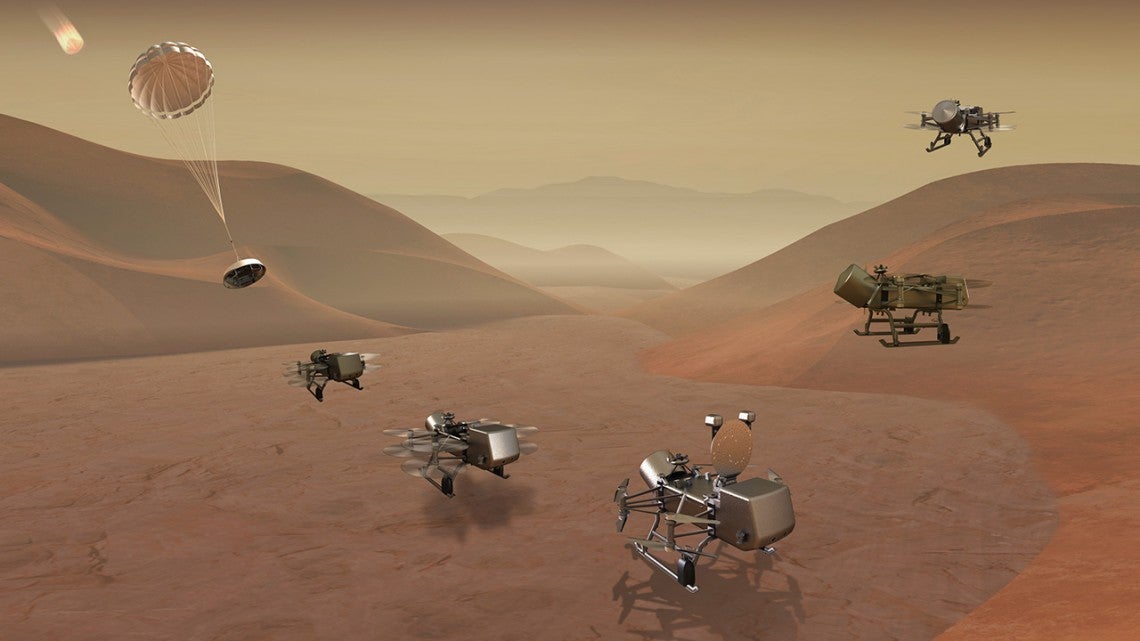The scientific objectives of the upcoming Dragonfly mission to explore Saturn’s moon Titan are described in a new research paper, along with the instruments required to fulfil these goals.
With launch expected around 2027, Dragonfly should take to Titan’s skies at some point in the mid-2030s. By that point I’ll be in my mid-60s — a full-fledged senior citizen — but I’ll undoubtedly follow the mission with child-like enthusiasm. For you see, Titan is my favourite place in space (outside of Earth, of course), owing to its many peculiar, enigmatic, and sometimes familiar features. Also, as a dedicated fan of Frank Herbert’s Dune series, I’ve always imagined Titan — with its oily surface — as resembling the fictional Harkonnen planet of Giedi Prime.
Titan is the only moon in the solar system to feature a dense atmosphere and significant quantities of liquid on the surface, even if that liquid takes the form of hydrocarbon seas and lakes. Gigantic sand dunes drape its tropical regions, the result of cosmic rays blasting the moon’s surface ice. Titan also features a vast equatorial desert, called the Shangri-La sand sea, which hosts the occasional dust storm. In that sense, the moon also resembles Arrakis from Dune (no word yet if Titan hosts gigantic sand worms, or Harkonnens for that matter).
This is an ideal destination for a robotic probe, as Titan is brimming with scientific targets. As a mission, Dragonfly has been a go since 2019, but the formal objectives of the mission were only recently disclosed. Jason Barnes, deputy principal investigator of the Dragonfly mission and a professor of physics at the University of Idaho, is the first author of the new paper, published in the Planetary Science Journal.

Dragonfly is a dual-quadrotor drone that will feature eight rotors, each measuring around 1 metre in length. With NASA’s Ingenuity helicopter currently buzzing around Mars, Dragonfly will become the second aerial vehicle to fly on an alien world and the first to take flight on an alien moon.
This won’t be the first-ever mission to Titan. NASA’s stationary Huygens probe landed there in 2005, capturing some of the eeriest photos I’ve ever seen, and the Cassini probe, which circled Saturn for 13 years, used its radio capabilities to peer through Titan’s thick cloud tops. But Dragonfly will take the scientific exploration of Titan to the next level.
“Titan represents an explorer’s utopia,” Alex Hayes, associate professor of astronomy in the College of Arts and Sciences and a co-author of the new study, said in a statement. “The science questions we have for Titan are very broad because we don’t know much about what is actually going on at the surface yet. For every question we answered during the Cassini mission’s exploration of Titan from Saturn orbit, we gained 10 new ones.”
As the new paper points out, Dragonfly will partake in what is primarily but not exclusively an astrobiology mission. The aerial drone will search for biosignatures (suggestive of previous or current biological processes) and take measurements related to the moon’s chemistry (including the molecular building blocks required for life) and the current potential for habitability.
Mission planners have chosen a landing site near Titan’s equator — a spot roughly 700 km north of where Huygens landed. Dragonfly will explore the Shangri-La sand sea and possibly even visit the Selk impact crater — a possible cradle of life.
The mission will primarily take place during the northern hemisphere winter. The half-ton drone should have no problem achieving flight, as Titan’s gravity is one-seventh that of Earth’s, the winds are gentle, and the atmosphere is thick enough to produce lift. Mission scientists aren’t anticipating that rain — consisting of liquid methane — will be a problem, but they’re not entirely sure.
Dragonfly, a “rotorcraft relocatable lander,” in the words of the researchers, will spend most of its time on the ground performing science and transmitting its data back to Earth. The aerial drone will only fly for between 30 minutes and one hour once every two Titan days, in which one Titan day is equal to 16 Earth days. The team will select new destinations on the fly, so to speak, in a manner similar to how target destinations are chosen for Martian rovers.
The drone’s payload will consist of eight scientific cameras, two spectrometers, and a drill to sample for complex organics. Dragonfly will also carry a geophysics and meteorological suite with 11 different instruments capable of measuring air temperature, air pressure, wind speed and direction, and humidity.
Where Cassini was able to provide grainy radio images from space, Dragonfly will do the ground truthing needed to confirm or disprove theories about the moon’s chemical processes and atmospheric surface interactions. The team will also study the role of tropical deserts in Titan’s global methane cycle.
“My primary science interests are in understanding Titan as a complex Earth-like world and trying to understand the processes that are driving its evolution,” said Hayes. “That involves everything from the methane cycle’s interactions with the surface and the atmosphere, to the routing of material throughout the surface and potential exchange with the interior.”
The search for potential biosignatures will include “life as we know it,” that is, life that needs liquid water to survive, and “life, but not as we know it,” such as life capable of finding a home in Titan’s liquid hydrocarbons, according to the paper.
Finding the ways in which Titan is similar to Earth, or the ways in which a young Earth may have resembled Titan, is obviously very important, but I’m just as interested in knowing all the ways Titan is not like Earth. Come the 2030s, I’ll be on the lookout for the exotic stuff, including further validation of Titan as the most alien place in the solar system.
